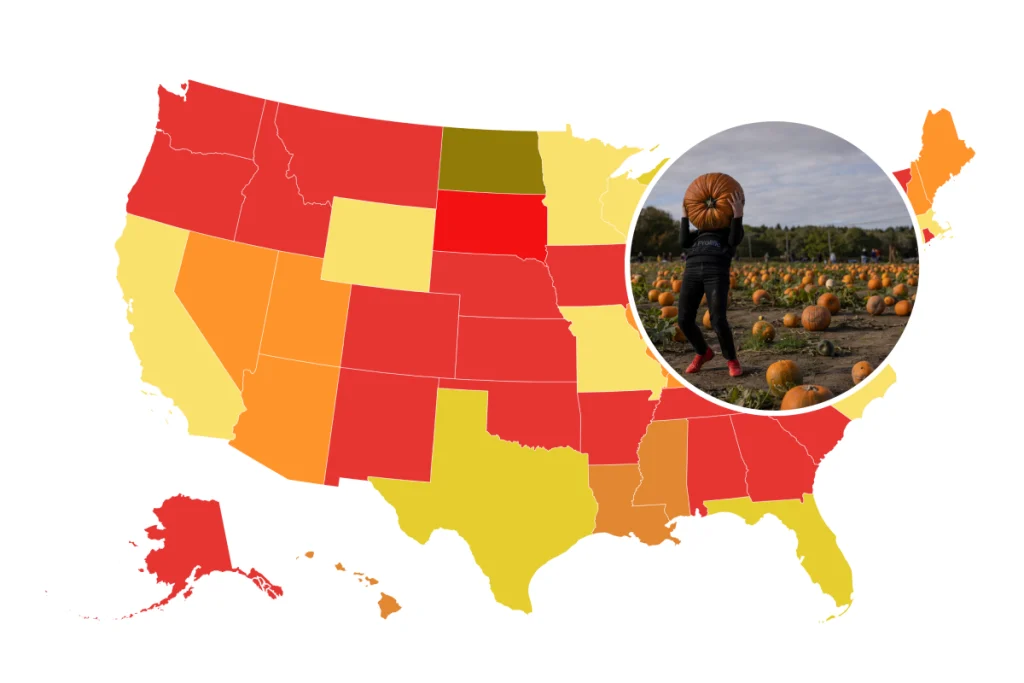America’s Fall Love Affair with Pumpkin: A Cultural and Culinary Phenomenon
As autumn leaves carpet the ground and a distinctive crispness fills the air, Americans across the country are embracing the season’s signature ingredient: the humble pumpkin. A recent survey by Coffeeness has mapped out America’s favorite pumpkin treats state by state, revealing our diverse yet unified passion for this iconic fall vegetable. The findings, compiled by Newsweek into an accessible map, show that while tastes may vary regionally, our collective enthusiasm for pumpkin-based delicacies remains stronger than ever. This seasonal obsession speaks to something deeper than mere culinary preference—it reflects cultural traditions, agricultural connections, and a distinctly American identity that has evolved over generations.
Pumpkin’s cultural significance extends far beyond its nutritional benefits, though those shouldn’t be overlooked. According to Cindy Ott, an associate professor of history and material culture at the University of Delaware, the pumpkin represents America’s enduring connection to agricultural traditions and small family farms. “American families are driving 30 miles from their home in the city out to the country to buy this vegetable that they’re not even going to eat,” Ott explains, highlighting a fascinating paradox. While we cherish pumpkins symbolically, the U.S. Department of Agriculture estimates that of the nearly 2 billion pounds of pumpkins produced in the United States annually, over 1.3 billion pounds end up discarded. Yet this seasonal ritual of selecting pumpkins from local farms sustains a tradition that connects urban Americans with their rural roots. What began as a practical food source in colonial America has transformed into a powerful cultural symbol—one that appeared on the cover of Time magazine after 9/11 as a pumpkin pie with an American flag, representing resilience and national identity during a moment of crisis.
The survey reveals fascinating regional preferences in pumpkin consumption across America. Pumpkin bread emerged as the overall favorite, particularly beloved in the South and Mountain West regions where its warm, spiced flavor perfectly complements cool autumn evenings. The Northeast corridor and parts of the Midwest showed a stronger preference for pumpkin muffins, perhaps reflecting the grab-and-go breakfast culture in more urban environments. Pumpkin cookies secured third place nationally, while pumpkin soup—a more savory application—claimed top spot in four states, demonstrating Americans’ growing willingness to explore pumpkin beyond sweet applications. Roasted pumpkin seeds, a zero-waste option that addresses the sustainability concerns around pumpkin consumption, led in three states. Surprisingly, the pumpkin spice latte—often perceived as the catalyst for modern pumpkin mania—was the favorite in just one state, suggesting our pumpkin preferences run deeper than recent commercial trends.
The pumpkin’s journey through American culture reveals how a once-overlooked vegetable transformed into a powerful national symbol. “The pumpkin was something that was just like food, nobody paid attention to it, like, you know, historically in the colonial era,” Ott notes. “And then once it became something that represented ideals for American and the ideals they represent, or like the agrarian myth and the small family farms, then they turned it into a pie of Thanksgiving.” This transformation speaks to the pumpkin’s unique ability to embody American values of hard work, agricultural heritage, and community. What makes this particularly interesting is the seasonal nature of our relationship with pumpkin—while deeply important symbolically, most Americans only consume pumpkin pie once or twice a year, typically around Thanksgiving. The limited consumption doesn’t diminish its cultural significance; if anything, it enhances the special anticipation associated with pumpkin season.
The pumpkin phenomenon illustrates the powerful intersection of food, tradition, and economic sustainability in American culture. While critics might view seasonal pumpkin obsessions as commercialized trends, Ott’s research suggests something more meaningful is occurring. Her interviews with farmers across the country reveal that the annual surge in pumpkin-related activities—from picking to carving to baking—genuinely helps sustain small family farms that might otherwise struggle to remain viable in today’s agricultural economy. The agritourism opportunities created by pumpkin patches, hay rides, corn mazes, and farm stores provide crucial supplemental income for these operations. In this way, the symbolic representation of rural America through pumpkin-related traditions actually helps preserve the very lifestyle it celebrates—creating a rare virtuous cycle where cultural symbolism translates into economic support for the traditions being honored.
As we move deeper into the fall season and toward the winter holidays, pumpkin serves as just the first in a parade of seasonal foods that Americans embrace as part of their cultural heritage. From Thanksgiving sides to Halloween treats, these seasonal delicacies do more than satisfy our palates—they reinforce our connections to cultural traditions, agricultural cycles, and shared national identity. The pumpkin’s journey from practical colonial food source to beloved seasonal ritual demonstrates how food carries meaning beyond nutrition, becoming vessels for nostalgia, community, and values. In a nation as diverse as America, the widespread enthusiasm for pumpkin in autumn provides a common cultural touchpoint—one that crosses regional, political, and demographic boundaries. Whether manifested as bread in Alabama, muffins in Massachusetts, or soup in Oregon, the pumpkin unites Americans in a shared seasonal experience that both celebrates our agricultural past and sustains those traditions for future generations to enjoy.















